grab our FREE
‘Do’s & Don’ts of what to add to your website’ Guide.
‘Do’s & Don’ts of what to add to your website’ Guide.
emails with additional helpful content.
Hi, we're so glad you found us.
We love helping creatives like you finally have the website you’ve always wanted.
few simple steps
Follow us
Should you use Purple as your Branding Colour?
Purple is often associated with magic, mystery and creativity. But, this non-traditional hue can also have a polarizing effect, with people finding its luxurious and royal look too aloof and vain. Are you Team Purple? Let’s discover whether you should use Purple as your branding colour.
In this blog, we have developed a three-part system that takes a deep dive into Purple’s meaning, varieties and how to use this information in your branding.
Are you ready to dive into the most creative colour of all? The power of Purple is waiting!
Before we start – missed a part of our Branding Colour Series? Catch up below.
- 1. Should you use Blue as your Branding Colour?
- 2. Should you use Red as your Branding Colour?
- 3. Should you use Yellow as your Branding Colour?
- 4. Should you use Green as your Branding Colour?
- 5. Should you use Pink as your Branding Colour?
- 6. Should you use Orange as your Branding Colour?
- 7. Should you use Purple as your Branding Colour? (this is the blog you’re reading)
- 8. Should you use Grey as your Branding Colour?
- 9. Should you use White as your Branding Colour?
- 10. Should you use Black as your Branding Colour?
- 11. Should you use Beige as your Branding Colour?
- 12. Should you use Brown as your Branding Colour?
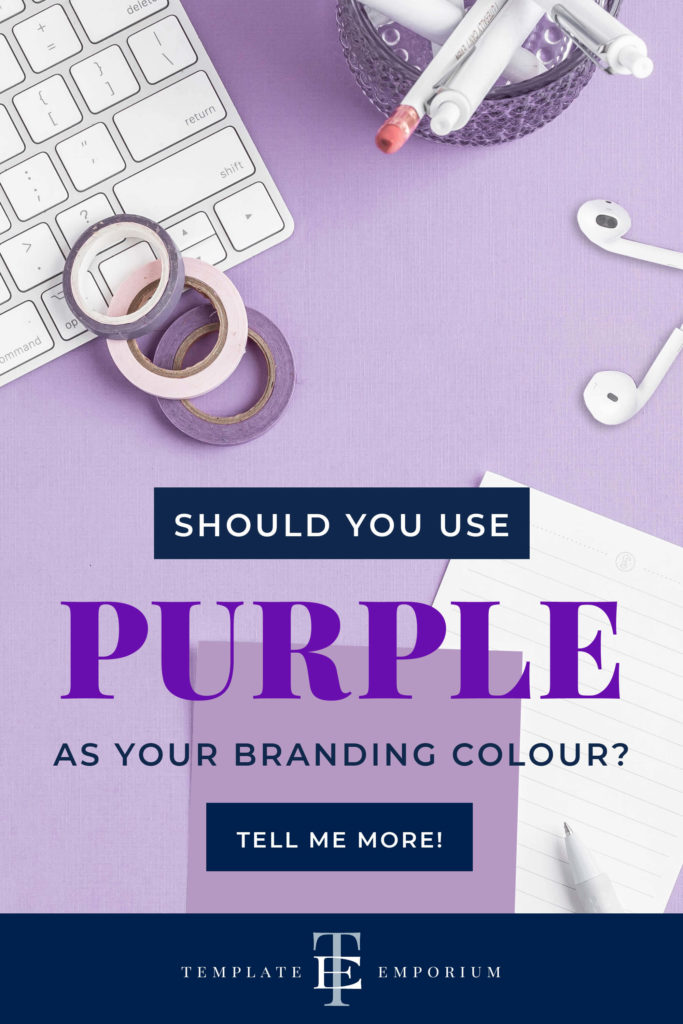
Want to start using Purple as your Branding Colour now?
Download our FREE Guide
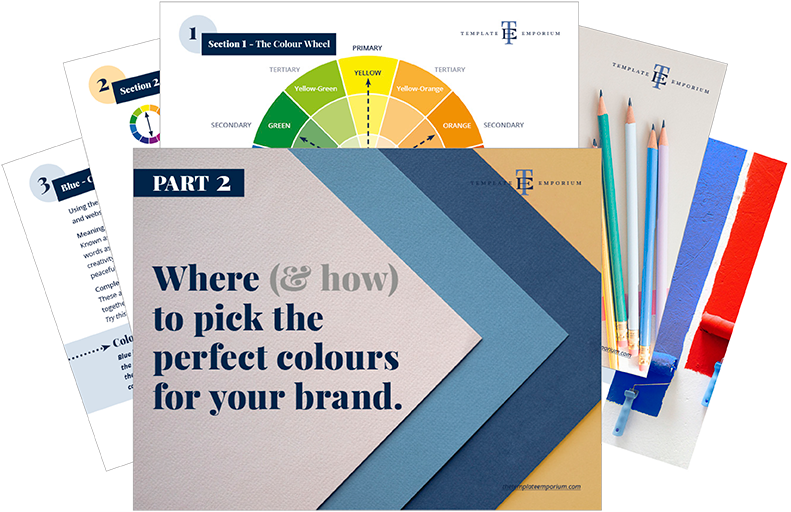
Here’s What We’ll Cover
MEANING OF PURPLE
The Psychological Meaning of Purple
Meaning of Purple to you
Purple in Business
VARIETIES OF PURPLE
From lavender to Royal Purple, we share our favourite Purples
Purple & The Colour Wheel
Colours that go with Purple
PURPLE IN BRANDING
Matching to the Tone of your Business
Picking the Perfect Palette with Purple
When not to use Purple in your Branding
Should you use Purple as your Branding Colour?
1. Meaning of Purple
The Psychological Meaning
Purple may conjure up the feeling of relaxation, spirituality and femininity with the coolness of the purple fragrance floating in the air from Lavender, Lilac, and violets.
But, purple also goes hand-in-hand with luxury, royalty and wealth. And this can leave some feeling the arrogance of this colour uncomfortable. So, how can two very different meanings of one colour possibly be correct?
We believe it is based more on the shade of Purple rather than the colour itself. And to make it a little easier, we’ve created an icon guide below and broken it into Light, Bright and Dark Purple.
Original unedited icons from the Noun Project
Light Purple Meaning
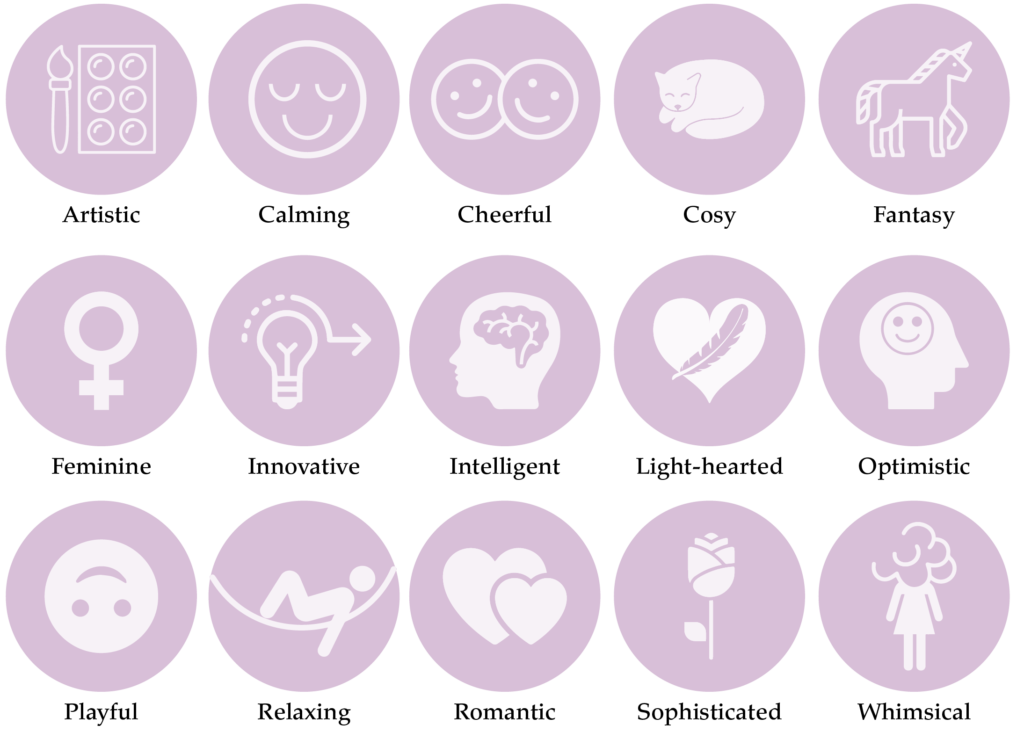
Bright Purple Meaning

Dark Purple Meaning
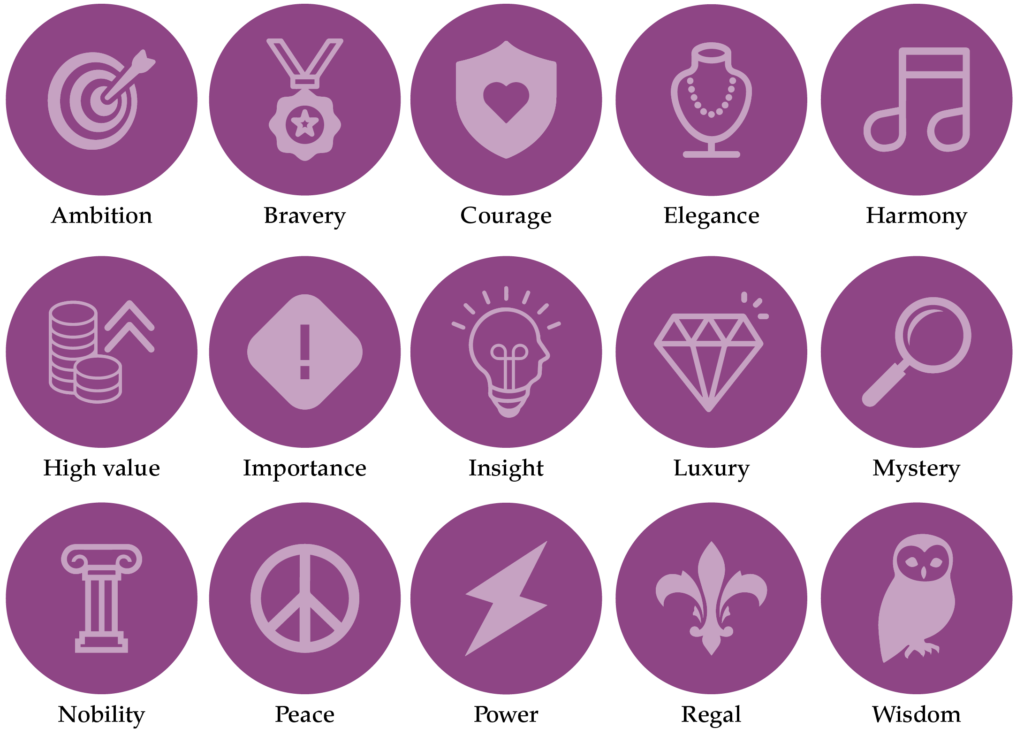
Meaning of Purple to You
How do you feel about Purple? Is it a colour you would like to incorporate into your branding? Or does it feel too whimsical, playful and too light-hearted?
Any experiences or memories you’ve had with Green will help determine how you feel about it.
Purple, for me, has wonderful childhood memories from the big friendly purple blob that is McDonald’s Grimace. To the catchy Halloween sing-a-long song of The Purple People Eater. And my love of Purple continued with the Prince of Purple with his purple-inspired classic, Purple Rain.
If you’re a personal brand, the key is to find a balance between the colours you like and the ones that will attract your ideal client.
Look at the icons above and pick which words sum up the way you feel about Purple. Or the way you want your business to be perceived. Doing this will be a great way to determine the shade of Purple that’s right for you.
Colour Clues
Every colour makes us feel a certain way. Once you learn how to use the Indoor Clues, (more about that below) it will open your eyes to new options and feelings about colour.
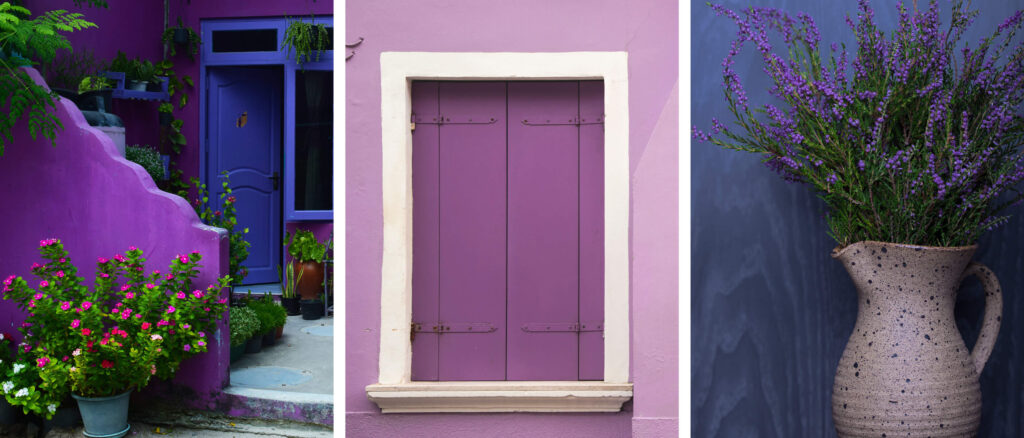
Do you have Purple in your home? An easy way to start is with a small potted purple plant such as a potted violet or a bunch of lavender. Introducing it in small doses and lighter shades will allow you to slowly become accustomed to this powerful colour and decide whether it could work in your branding.
The question now becomes, Would your ideal client like Purple, and how would it make them feel?
In Part 1 of our Colour Guide series, “How (& where) to pick the perfect colours for your brand.” we explain everything about Colour Clues. Click here to download it – it will also answer any further questions you have.
Purple in Business
As discussed earlier in The Psychological Meaning of Purple, picking the right shade of Purple that reflects your target audience is the key to using this bold, non-traditional, creative colour.
Here are some examples of how simply picking a different shade of purple gives a different meaning and look to a company.
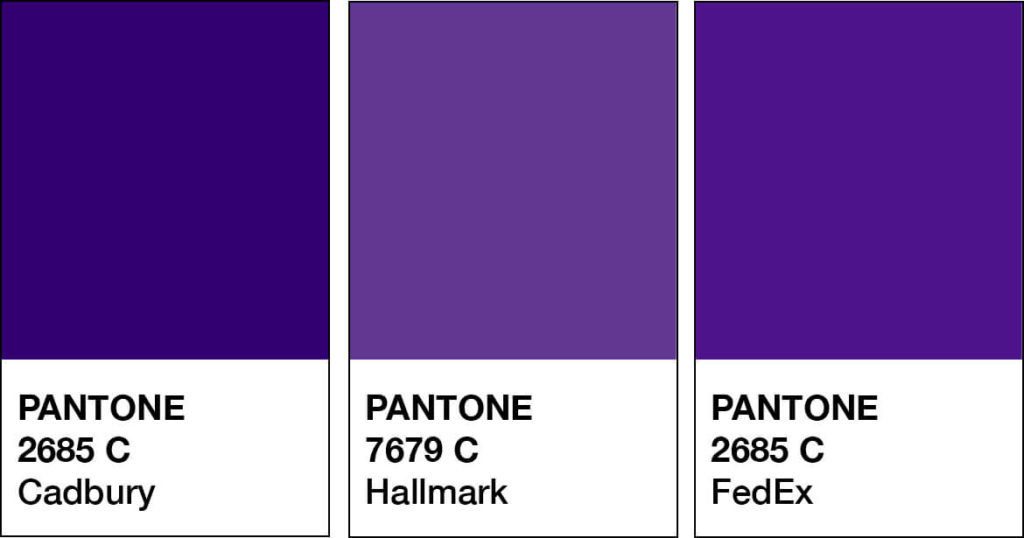
Food & Beverage
Purple is popular amongst brands that want to look unique while still conveying mystery and nostalgia, and purple does all of that for these brands.
Disney
Purple isn’t an official branding colour of Disney. However, they have managed to incorporate it amongst the Villians of Disney.
Using characters such as Ursula from The Little Mermaid below and Maleficent from Sleeping Beauty, purple represents power, royalty and over-ambition. (Photo – Brian McGown Unsplash).
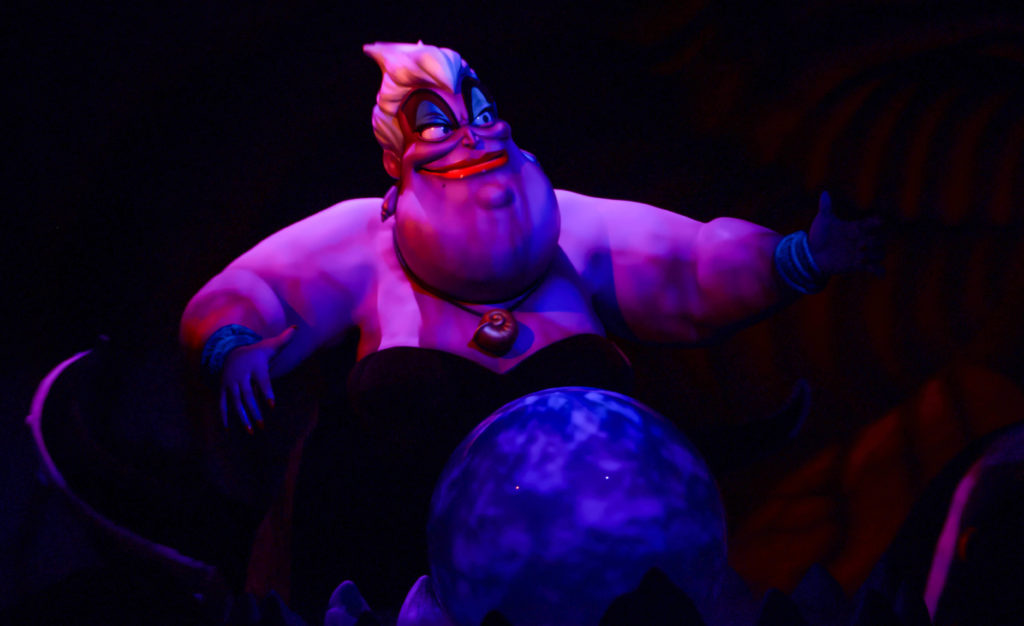
While also using it to incorporate the creativity and imagination side of purple in the dragon Figment – the unofficial mascot of Epcot.
Disney Parks Colour Trends
As mentioned in previous posts, Disney loves to create their version of a colour and use it throughout the parks.
Look out for Purple Potion on Minnie’s ears. Disney then took this unique purple and turned it into an Instagrammable Purple Wall and, due to its popularity, turned that into a backpack and sold it throughout the parks. Now that’s making good use of your colour branding!
Should you use Purple as your Branding Colour?
2. Varieties of Purple
From Lavender to Royal Purple, we share our favourite Purples
Purple is both a COOL & Secondary colour. It’s made by mixing two primary colours (Blue + Red) together. These primaries (Blue + Red) appear on either side of Purple on the colour wheel.
Many varieties of Purple may look similar to each other but have different names. From light to dark Purple we’ve compiled a cheat sheet of our favourites below (and included a few you may have never heard of!).
And to make it easy, we added the hex numbers. So you can start using them in your branding today.
Press play on the image below or get all the colour breakdowns in our FREE Guide.
Insider Tips
To make Purple, mix Blue and Red.
Tints of Purple = Lighter varieties reflect the fun and youthful audience. It feels more approachable and friendly. Such as Lavender, Periwinkle Purple, Mulberry or Thistle.
Shades of Purple = Darker varieties attract a more mature audience. If your business is more traditional, a deeper purple such as Royal Purple, Eggplant, Plum or even Pompadour is a safer option.
Purple & The Colour Wheel
One of the questions we often get asked is What colours go together? And the best way to ensure you always get it right is to use the Colour Wheel.
There are 12 hues (colours) on the wheel and consist of the:
1. Primary
2. Secondary
3. Tertiary
In this post, we’re focussing on Purple which, is a Secondary Colour.
Want Your Own Colour Wheel? Get it now in our FREE Guide
Purple & Monochromatic
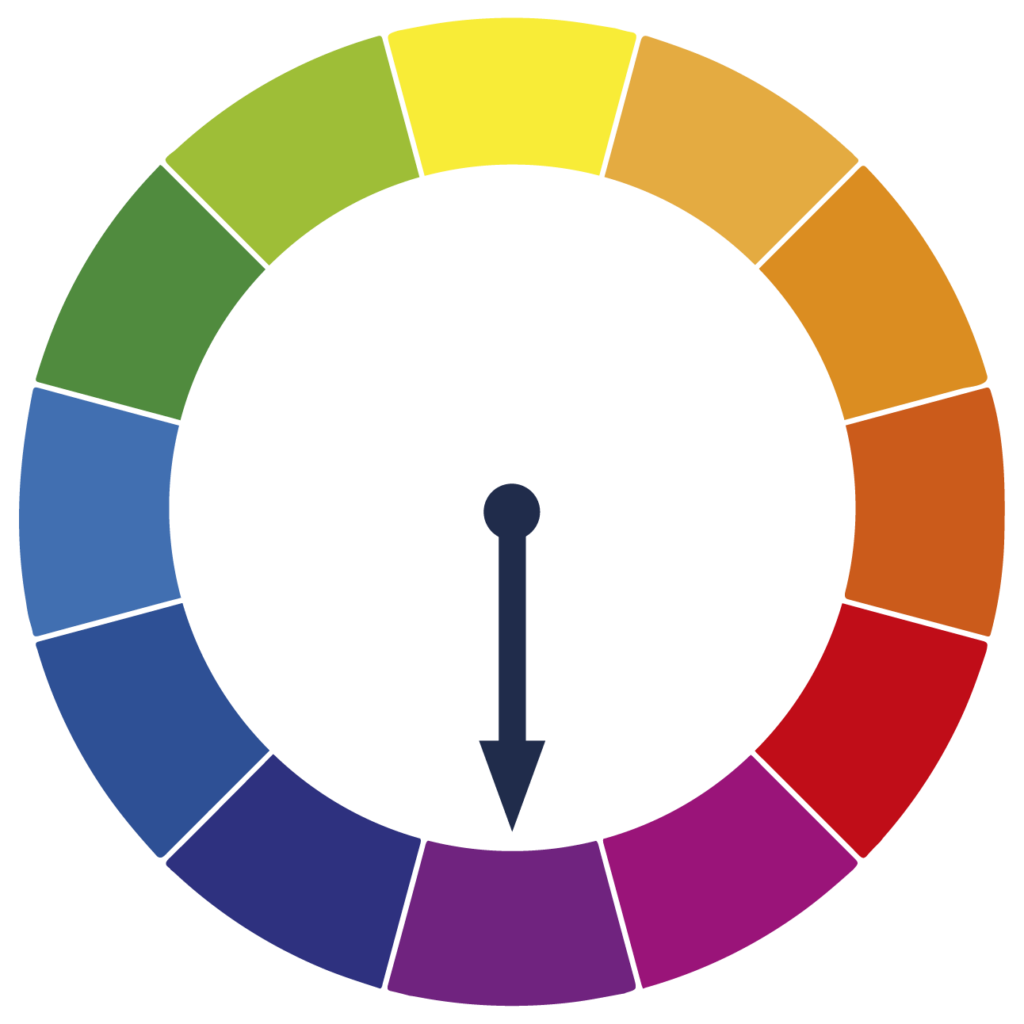
- Monochromatic refers to using one colour only.
- Take your one MAIN colour Purple and add in light and dark variations.
Using one hue (Purple) and adding increasing amounts of:
- White creates a tint of Purple by lightening it. E.g. Lavender
- Grey creates a tone of Purple by desaturating it. E.g. Plum
- Black creates a shade of Purple by darkening it. E.g. Aubergine
Purple & Complimentary Colours
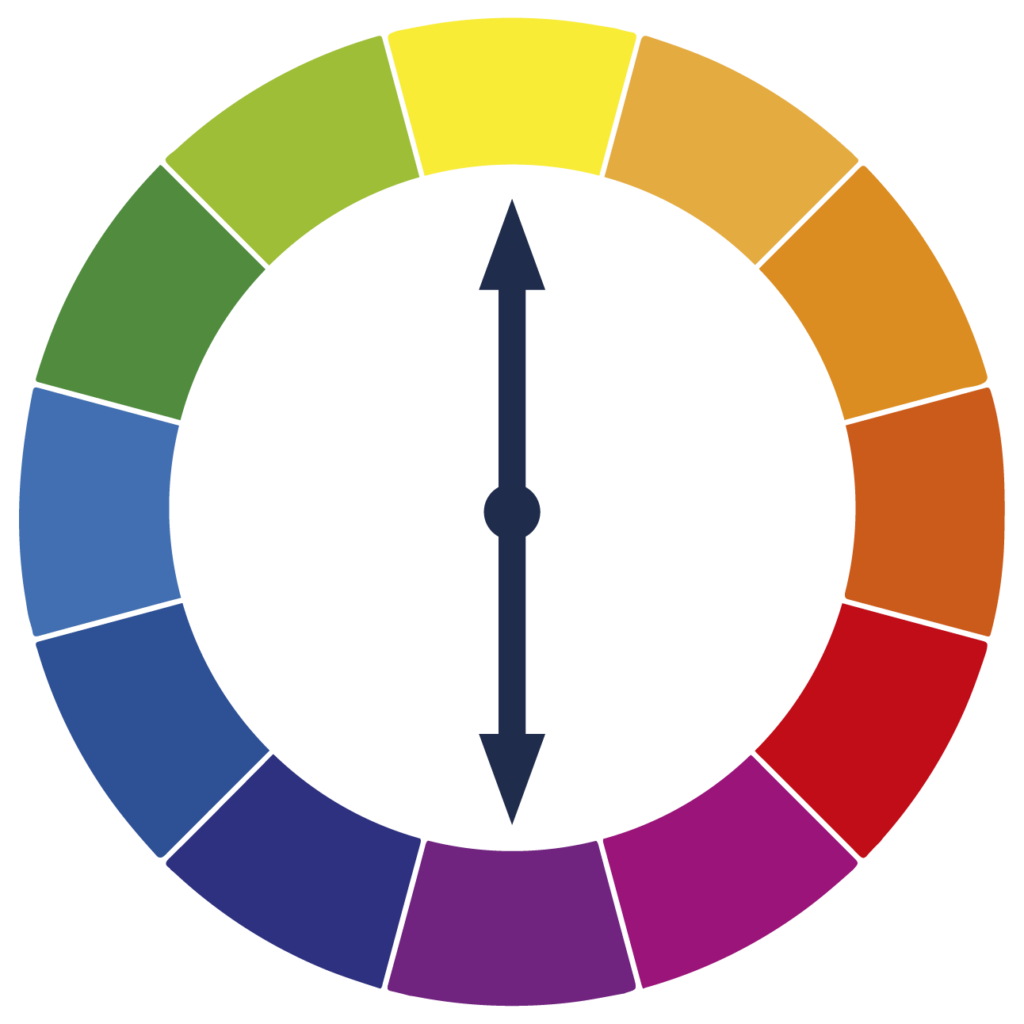
- Complimentary refers to the use of two colours.
- These are colours that are opposite each other on the colour wheel.
- When used together, they bring out the best in each other.
Using your MAIN colour Purple, with its opposite Yellow will create contrast and make the colours look brighter and more vibrant.
Insider Tip
Use the Complimentary Colour Yellow in small amounts, making it more of a pop of added colour or an accent.
To avoid them overpowering each other, mix in tints, tones and shades.
Using a lighter shade of Yellow means it will fade back. Allowing the Purple to come forward.
Purple & Analogous Colours
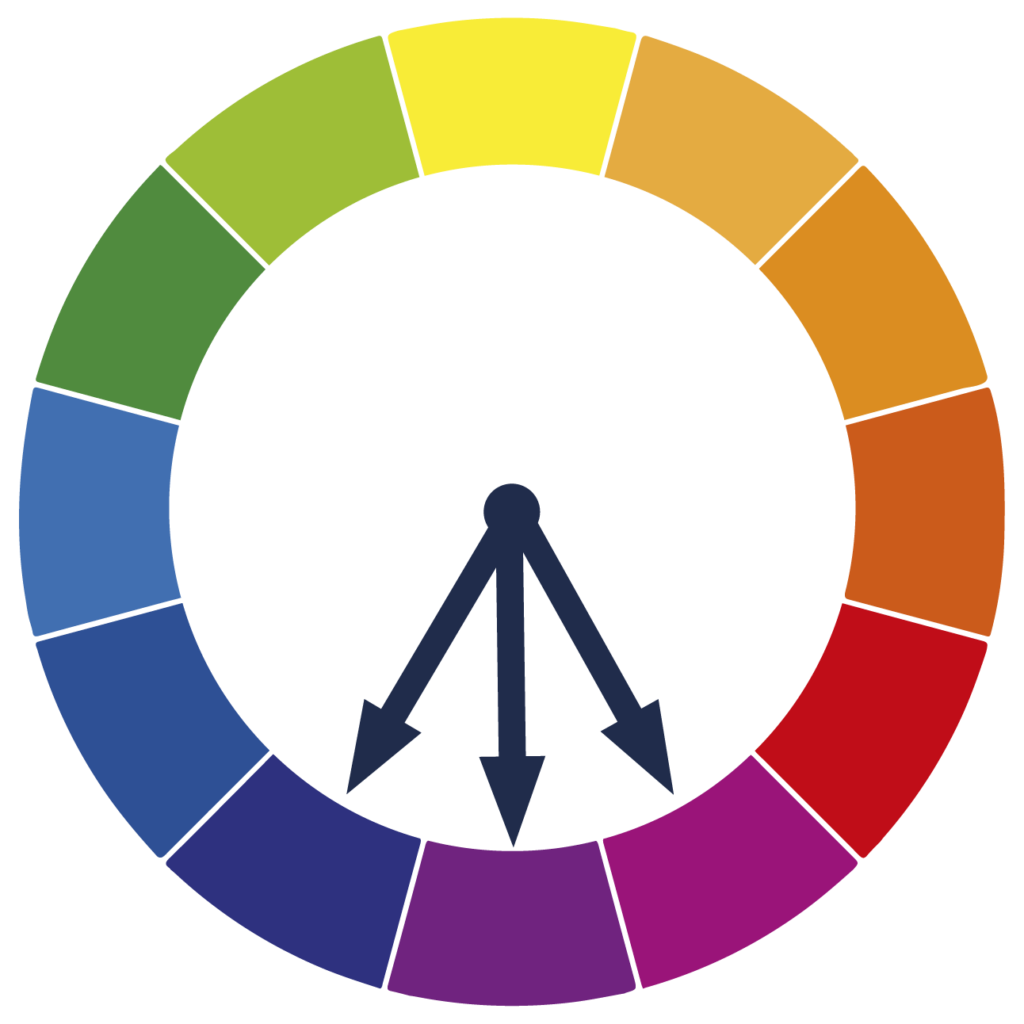
- Analogous refers to the use of three colours.
- These are any three colours that are side-by-side on the colour wheel. Think of them as colour neighbours.
Using your MAIN colour Purple, find the two similar supporting colours sitting next to each other.
In this case, it will be Blue-Purple + PURPLE + Red-Purple.
The undertones of these colours are similar. Which helps convey a low-contrast, friendly, harmonious mood and will appear easier on the eye.
Purple & Split Complimentary Colours
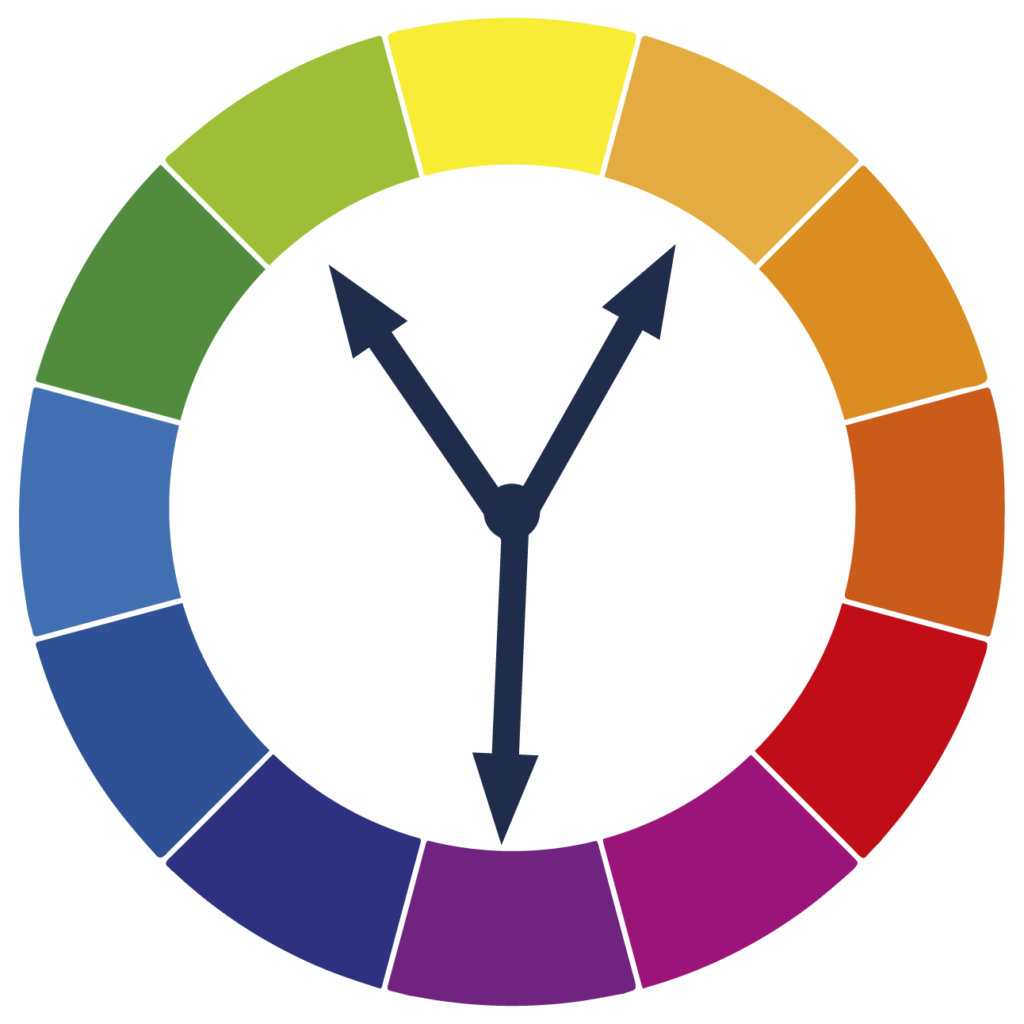
- Split Complimentary is the use of two colours.
- This is using a base colour and the two colours on each side of its complement.
When your MAIN colour is Purple, its complementary colour is Yellow. The two colours on each side of the Yellow are Yellow-Green and Yellow-Orange.
A combination like this creates a low-contrast palette of Analogous colours. And the opposite colour gives a pop of colour.
Insider Tip
This time, we’re going to do the opposite of what we did with the complementary colour palette. Now the MAIN colour Purple is used as the Accent.
Colours that go with Purple
Picking colours that go with a powerful hue like purple can feel overwhelming. And how to make it work well with others?
Next up, we’re going to put into practice everything we’ve learnt about the Colour Wheel and test it out with the examples below.
Blending Purples

As discussed earlier, a monochromatic palette refers to using one colour.
We love combining Purple with Purple because not only does it elevate the look, but the multiple shades of Purple create harmony together.
Try adding Light and Dark variations together.
The lighter shade will soften, while the darker one will be the highlight.
Purple Colour Combinations

Purple & Blue
These analogous colours sit next to each other on the colour wheel.
Lavender + Turquoise
Grape + Baby Blue
Purple + Royal Blue
Light Purple + Navy Blue
Royal Purple + Cyan
Purple & Green
This contrasting colour match complements each other beautifully.
Mauve + Moss Green
Aubergine + Olive Green
Beet + Sage
Vibrant Purple + Lime
Eggplant + Jade
Purple & Yellow
These complementary colours always look great together as they create contrast.
Violet + Gold
Eggplant + Mustard
Lavender + Lemon
Soft Purple + Bright Yellow
Orchid + Marigold
Purple & Grey
Using a neutral colour like grey allows Purple to really pop.
Plum + Grey
Lavender + Dove Grey
Lilac + Soft Grey
Eggplant + Slate
Violet + Silver
Purple & Pink
With Purple and Red being neighbours on the colour wheel, Pink (as a tint of red) is a natural pairing.
Iris + Dusty Rose
Amethyst + Vibrant Pink
Lilac + Dusty Pink
Deep Plum + Powder Pink
Boysenberry + Blush Pink
Purple & Brown
The neutral hue of Brown is a wonderful pairing with Purple.
Plum + Tan
Purple + Rust
Pastel Purple + Walnut
Purple + Chestnut
Lavender + Ochre
Purple & Red
Being colour neighbours on the Colour Wheel makes them the perfect pairing.
Violet + Poppy Red
Aubergine + Maroon
Royal Purple + Candy Apple Red
Periwinkle Purple + Lipstick Red
Lavender + Crimson
Purple & Orange
This cool and warm colour combination creates a wonderful balance.
Mauve + Cantaloupe
Violet + Orange
Eggplant + Peach
Indigo Purple + Punchy Orange
Fuchsia + Tangerine
Want more Purple Colour Combinations? Click the image below.

Should you use Purple as your Branding Colour?
3. Purple in Branding
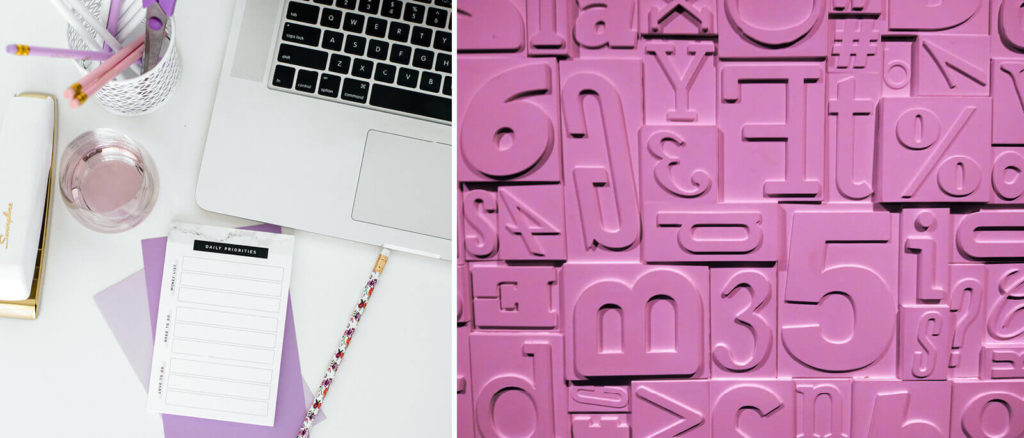
Matching to the Tone of Your Business
As discussed earlier, we break Purple into three options, light, bright and dark. Use this as a guide to help you pick the right shade of Purple for your branding.
Light Purple
Artistic. calming, cheerful, cosy, fantasy, feminine, innovative, intelligent, light-hearted, optimistic, playful, relaxing, romantic, sophisticated and whimsical.
Bright Purple
Awareness, creativity, daring, fun, impact, independence, intuitive, loud, magical, royalty, spiritualism, stimulating, strong, wealth and youthfulness.
Dark Purple
Ambition, bravery, courage, elegance, harmony, high value, importance, insight, luxury, mystery, nobility, peace, power, regal and wisdom.
Picking the Perfect Palette with Purple
Our 5-step Perfect Palette Process
Need help to choose your Brand Colour Palette? We’ve created a simple step-by-step process. Grab our free guide as a handy download.
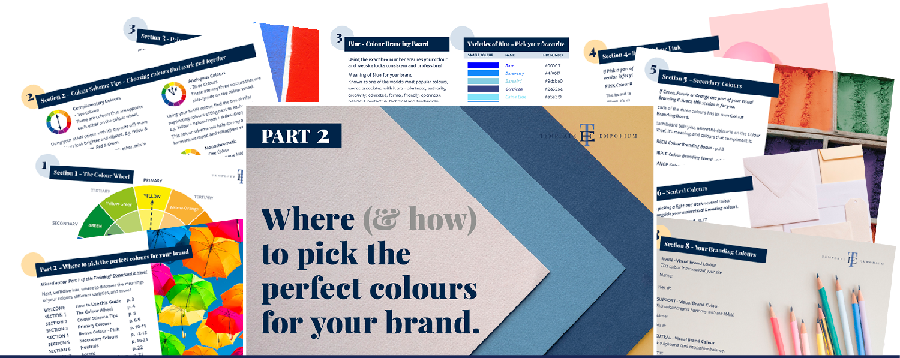
Step 1
Pick the Main Brand Colour
So you’ve picked Purple. Now you have to decide on the type of Purple, is it light, bright or dark?
Step 2
Pick a Support Brand Colour
If you feel stuck at this stage, just remember this colour creates harmony with the MAIN. Refer back to our tips earlier on Purple & The Colour Wheel and Colours that go with Purple to help you decide.
Step 3
Pick a Light Neutral Brand Colour
Why do you need neutrals in your brand colour palette? Because it creates balance.
Not sure which neutrals to pick? Go to page 16 of our free guide.
Step 4
Pick a Dark Neutral Brand Colour
Your light neutral colour needs a partner. So now it’s time to pick a dark neutral colour for even more balance.
Our guide on page 16 explains everything.
Step 5
Pick an Accent Colour
This colour is used to make something on your website pop. Therefore it’s only used sparingly.
Page 22 of our free guide will explain more.
Web and Print Branding

Once you have picked the right Purple for your business, add the hex code to your website.
View how it looks on both desktop and mobile. To create consistency only, use the one hex code number to ensure the Purple you chose is always the correct shade.
For print, instead of a hex code, you will need the CMYK (Cyan, Magenta, Yellow & Black) or Pantone, colour breakdown to ensure the Purple will print out the way you want.
When not to use Purple in your Branding
Purple can be a very polarizing colour because it’s a non-traditional hue and not as commonly used in branding as Blue, Reds or Green. Therefore it can feel foreign or uncomfortable to some people.
Luxury brands love using purple due to the idea that Purple conveys wealth and royalty. However, some business professionals may not take Purple seriously. Believing it’s too immature, playful and not professional enough, so make sure you know your audience before adopting it.
You Did it!
That’s a wrap on Should you use Purple as your Branding Colour?
How do you feel about Purple now? Is it a colour that would suit your branding? Let us know. And in the meantime, follow us on Pinterest for more blog posts like this.
Where to now?
Want to discover other colours for your branding?
- If your brand is youthful and fun – Check out Orange.
- Is your brand all about nature, growth and harmony? – Green may be a perfect match.
- If happy and energised is part of your brand DNA – Yellow is calling your name.
Don’t forget to download our FREE Colour Guide

Like the Blog Post?
PIN IT FOR LATER. And for more helpful tips follow us on PINTEREST.
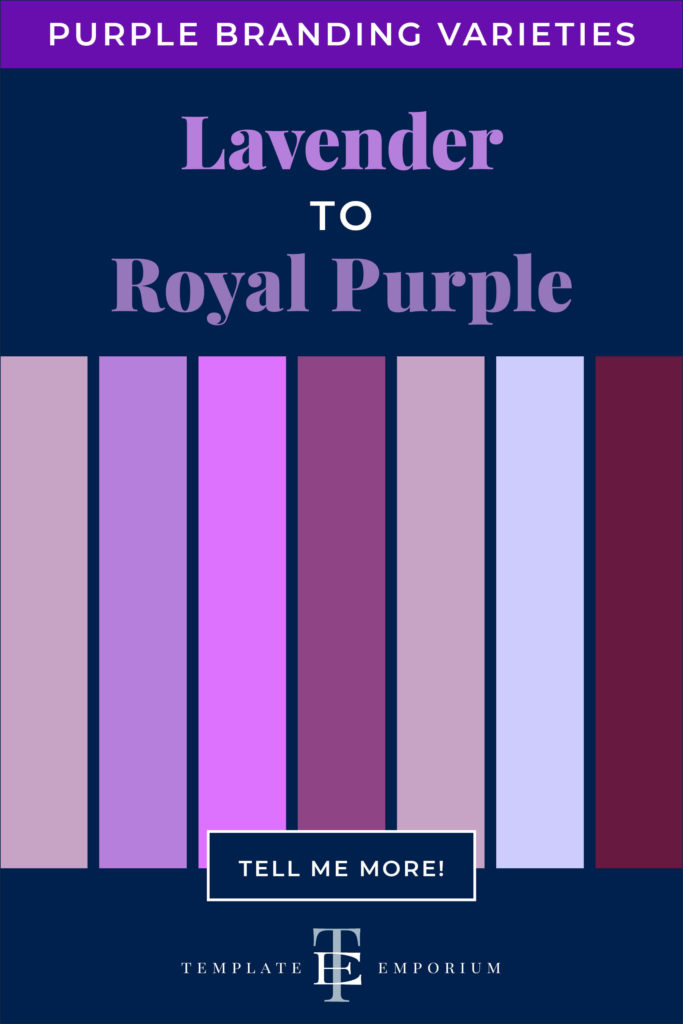
Search
Create & launch your website in a
few simple steps
FREE GUIDE
While you’re here,
grab our FREE
‘Do’s & Don’ts of what to add to your website’ Guide.
‘Do’s & Don’ts of what to add to your website’ Guide.
When you sign up, we’ll send you
emails with additional helpful content.
About Lavinia & Tom
Hi, we're so glad you found us.
We love helping creatives like you finally have the website you’ve always wanted.
Blog Categories
Follow us